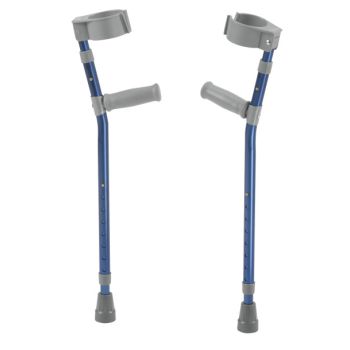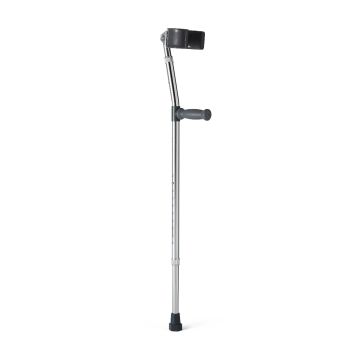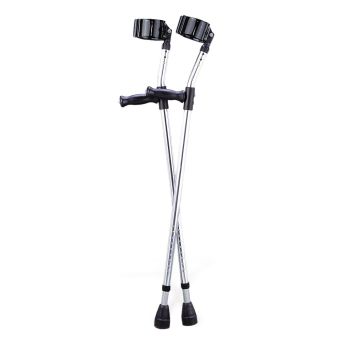Free shipping orders over $50
Forearm Crutches / Axillary Crutches
Whether you’re looking for the more common forearm crutches or axillary crutches, we have your needs covered. When a leg injury has been sustained and you need to reduce or eliminate the weight borne on the injured leg, you can greatly benefit from using walking crutches for additional stability and mobility. From adult crutches to heavy duty crutches, you will find your ideal mobility aid at AvaCare Medical. Read More...
-
Pediatric Forearm Crutches
Starting at $88.40 -
Bariatric Imperial Steel Crutches
Starting at $109.20 -
Underarm Crutch Cushion
$27.04 -
Standard Aluminum Crutches
Starting at $20.90 -
Red Dot Aluminum Crutches
Starting at $21.14 -
Push-Button Aluminum Crutches
Starting at $20.30 -
Adult Bariatric Crutches
Starting at $54.21 -
Guardian 7/8" Super Crutch Tip
Starting at $30.58 -
Medline Forearm Crutches
Starting at $35.55 -
Guardian Forearm Crutches
Starting at $40.48 -
1" Guardian Utility Tips
$26.26
What Are Crutches?
Crutches are a walking aid often prescribed to patients to provide them with more support so they can retain some of their mobility. They do not have to necessarily be prescribed though – one can easily buy crutches here at AvaCare Medical if you need replacement crutches to walk or if you are looking for a set of medical crutches at an affordable price.
Types of Crutches
There are many different types of crutches that are available on the medical market. Each type of crutch serves a certain purpose, and is meant for use by people with specific medical issues or conditions. The most commonly purchased crutches are:
Axillary Crutches
This is the most popular and well-known type of crutch that is used by the general public. Axillary crutches, or underarm crutches, are used to support a patient when one leg is almost entirely non-weight bearing. These crutches are commonly used for short-term purposes such as while the patient is recovering from injuries or is weak from surgery. Axillary crutches crutches are height adjustable. Before using them, however, it is important to adjust the crutches to the appropriate height to prevent nerve damage and provide proper support. In order to ensure accurate adjustments, follow these simple steps:
- Weight Capacity: Select a pair of crutches that are appropriate for the weight of the patient. Most crutches provide a weight capacity of 175 to 650 pounds.
- Crutch Height: The overall crutch height is correct when the top of the crutch is two to three inches below the armpit. When standing straight, the crutch cushion should not be touching the armpit.
- Hand Grip Height: The handgrip can also be adjusted for proper usage. The ideal handgrip height is at the height of the crease of the wrist when the arms are at one’s side, with a natural bend at the elbow.
Forearm Crutches
Forearm crutches (also known as Lofstrand Crutches, Canadian crutches, or elbow crutches) are for weight bearing patients and are intended for long-term use. Forearm crutches don’t need to be held by the hands, so they allow the person’s hands to be free for other tasks. They are commonly used by patients who suffer musculoskeletal disorders, polio, and other permanent disabilities. Just like axillary crutches, Lofstrand crutch canes are also height adjustable for a customized fit. There are several types of forearm crutch models; the choice depends on the user’s individual needs.
Bariatric Crutches
Bariatric crutches are actually a sub-type of both basic types of crutches, and are a very common choice as well. Many hospitals actually give bariatric crutches to patients, since they frequently have to accommodate patients who are different sizes and weights. The key difference between bariatric crutches and regular axillary or forearm crutches is the weight capacity. Most walking crutches have a weight capacity of 250 to 300 pounds. Some lightweight or petite crutches may have a weight capacity of up to 175 pounds. These are often used for more lightweight applications and for younger adults.
Frequently Asked Questions
There are many questions that people often raise when it comes to crutches, and for good reason. Many people need to know how to use crutches in different circumstances, where they can buy them on their own, which type of crutches to use, and much more. Here at AvaCare Medical, we understand that our customers want as much information as possible and we do our best to provide them with the answers they’re looking for.
In this section, we answer many common questions and provide as much information as possible about using and buying crutches. Crutches can be purchased in various places, but finding the the best crutches on the market can be a complicated process. This guide is meant to help you get a better understanding of medical crutches, so that you’ll have an easier time making that final decision.
Q: Where Can I Buy Crutches?
A: Some people look for crutches at retail stores as well as local pharmacies. The downside to this strategy is that local shops and medical suppliers have an extremely limited supply and variety to choose from. Medical supplies companies, in contrast, often have a much wider selection, and are also usually very knowledgeable about the product they are selling. For this reason, many people choose to purchase their crutches from trusted medical supplies stores, such as AvaCare Medical. We carry products from premier brands and manufacturers such as Drive Medical, Carex, Cardinal Health, Invacare, and many more.
Another thing to note when obtaining crutches is that they do not require a prescription (as many walking aids don’t). However, it may be best if your doctor does prescribe them so you can get the proper help you need and learn how to wear crutches and use them the right way. Depending on the leg injury and even the length of time that walking crutches are needed, one may need to get a certain type and use them a certain way. A doctor can also determine if crutches are the best mobility aid for a person or whether they could instead use a knee walker instead.
Q: How Can I Learn to Use Crutches?
A: Fortunately, there are many websites and guides that can teach users how to use crutches properly. A person’s doctor can even help teach them the basics of how to use crutches. The way a person uses a set of crutches also depends on numerous factors and situations.
Q: How Should Crutches Fit?
A: If you have a medical professional you can consult, the first question you should ask is how to fit crutches to best suit your body. This is extremely important since ill-fitted crutches may cause pain in the arms, armpits, wrists, and back. Visit our Adjustable Crutches page to learn more about adjusting crutches to fit.
Q: How Can I Prevent My Crutches from Causing Me Pain?
A: Crutch users often wonder how to use crutches without pain, and the truth is that there are many ways to make using crutches easier and less painful. One of the most common problems that people face is pain associated with the armrest and hand grips. Before initial crutch use and at times during use, keep in mind that proper positioning and adjustments remain the primary strategies for minimizing pain.
Tips for Using Crutches
As mentioned above, there are many things that affect users while using crutches. Even having insufficient strength can be a determining factor on whether a person can use crutches appropriately, or if a manual wheelchair may be the more suitable option. Some good tips on using crutches properly are as follows:
How to Hold Crutches Properly
Stand up as tall as possible and put the crutches under the arm. Hold the crutches is by grasping the middle of the handgrip while the top pad is placed properly and snugly under the arm. Users then must relax their arms, and make sure that the hand grips are level with the wrist. When gripping the hand grips, the elbow should be slightly bent to approximately a 30-degree angle.
How to Stand Up with Crutches
Changing from a sitting to a standing position may be difficult for some if they don’t know how to properly use their crutches. When trying to stand up with crutches, one should use the chair and the crutch at the same time. If possible, the user should use the chair with one hand and use the other hand to grasp the handgrip, push up with the hand on the chair, and then put the crutches under their arms appropriately.
There are times when a person won’t have a chair or place to hold onto while getting up (such as from a bench or stool without armrests). In these events, one can place the crutches directly in front of them with their arms extended and then grab the hand grips, pushing themselves up using the hand grips. After achieving a standing position using each crutch for balance, the user can place them under their armpits appropriately. With more practice, one can learn how to stand on crutches with ease.
How to Walk with Axillary Crutches
Crutches are often difficult for users if one hasn’t yet discovered the most practical ways to use them. While the basics of walking with crutches of different types may be similar, there are various tips to ensure maximum safety and stability. When using axillary crutches, one needs to make sure that first and foremost, the height is appropriately fitted to their bodies and armpits. The weight-bearing limits that a person has determines whether they are able to partially bear weight on their leg, touch their toes on the ground, or keep their foot elevated.
The best way to walk with axillary crutches is to lean forward, using the crutches for support between the upper arms and ribs. The weight should be put on the hands, and not the armpits (more on that later). Move the crutches ahead of the body, and move the injured leg forward so it’s even with the crutches. Put as much weight as needed if one can bear weight on the foot at all; otherwise, bear the upper body weight on the crutch. Next, one needs to step past the crutches with the uninjured leg. In short, one needs to move the crutches, the hurt limb, and then the uninjured leg in that order. It may take some practice, but once a user has done it enough times, they’ll find that it can be done in one smooth process.
How to Walk with Arm Crutches
Forearm crutches are a little bit different, as they rely solely on the user’s upper body and arm strength. The order is about the same in terms of movement, but it is important that with forearm crutches, one doesn’t put the crutches in front of their bodies too far – normally about 12 inches is a good distance. With the injured foot forward, use a swinging motion to move the injured foot off of the ground and in front of the crutches. To minimize shock to the uninjured foot and leg, it is important that the crutches are the appropriate height. If you find that you are hitting the ground too hard with either the crutches or the uninjured foot, then taking smaller steps at a time or adjusting the crutch handles may be beneficial for you.
How to Use Crutches on Stairs
Stairs are often an extremely difficult task for users who have crutches. While the most prudent would be to avoid stairs altogether when on crutches, sometimes stairs are unavoidable. In these cases, one be assured that with practice, they can get up and down stairs with ease.
Learning how to walk up stairs with crutches is a task that can take time. Some stairways have a handrail. In such scenarios, it is best to use the handrail with one hand while using the other crutch as normal for support (many times, one can hold the other crutch at the same time with one hand). If a user does not have a handrail, the user needs to rely on both crutches for support. Going up the stairs with crutches is a process, and the best way to do it is to step up with the stronger leg first, and make sure that balance is obtained. Then, one can bring their injured leg up with the crutches at the same time.
When trying to learn how to get down stairs with crutches, one should do the opposite of what they do to go up the stairs. First, the crutches and the affected leg need to be brought down a step, while bending the uninjured knee. Then, when putting the weight on the crutches and the uninjured leg, one can slowly move their leg so that it doesn’t become injured. One should always make sure that they have their balance in check before moving up or down to the next step on the stairway.
How to Use Crutches for Both Legs
Sometimes, a user who doesn’t have to use a wheelchair may be given crutches if they are able to do some weight bearing. However, depending on the injury, one needs to know that they may need an alternate method of mobility and support instead of crutches (such as when managing two broken legs). If a user has some weight bearing capabilities on both legs, then the way they use crutches differs.
Start by leaning appropriately on the crutches. While holding the body up with one crutch, simply swing the other arm forward with the other leg as if taking a step, being careful not to move it too far forward. Always put the majority of weight bearing on the crutch instead of the leg, and then put the leg on the ground. Next, move the opposite arm and leg in the same motion, placing the crutch on the ground before the injured foot or leg. By doing this, one may notice that it creates much of a “waddling” motion. It is important that the user doesn’t put more weight than necessary on their injured legs, though.
How to Use Crutches with One Leg
Crutches are usually the ideal choice when a user needs to have mobility while managing a single leg injury. By following the tip above on “How to Use Axillary Crutches”, one can find the most common way to use crutches with one leg. In some cases, though, a single crutch may be used when only one leg or foot is injured. In order to do so, one needs to do things a bit differently than they would if using two crutches.
When using one crutch and one leg, the crutch needs to be used on the side of the uninjured leg. The crutch should be moved forward and placed on the ground parallel to moving the injured leg or foot. While keeping as much weight off of the injured leg as possible, lean onto the crutch and step past the crutch with the uninjured leg. Repeat this method in order to continuously move forward. It is important that a user takes extra precautions and care while using one crutch.
At AvaCare Medical, we want to ensure that you get the best crutches to suit your needs, and we can help you choose the right product. If you have any questions or concerns, don’t hesitate to give us a call at 1-877-813-7799, chat with us onsite, or send us an email anytime – our customer care team will be happy to speak with you! When placing a crutches order from AvaCare Medical, keep in mind that all orders over $50 qualify for free shipping – and we’ll do our best to ship your order out the same day you place it! Shop now!














